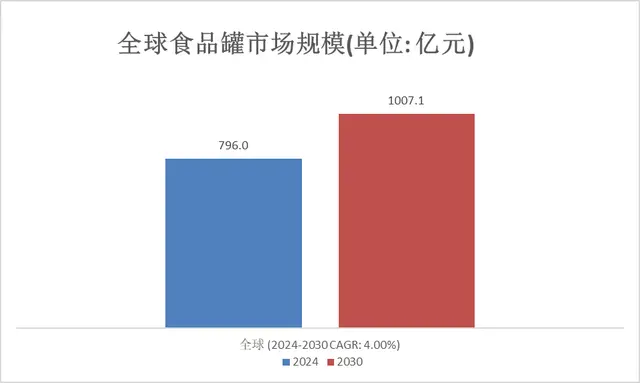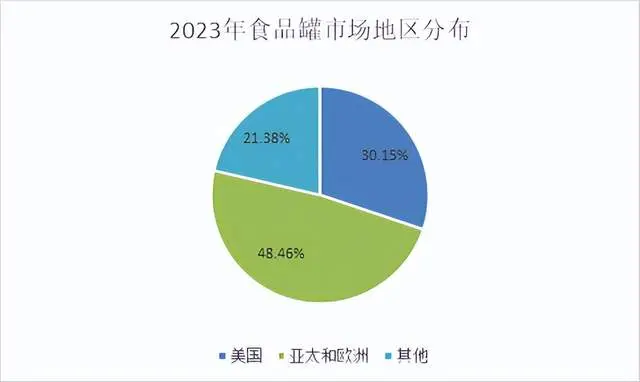
The global food can market will reach 79.6 billion yuan in 2024 and is expected to reach 100.71 billion yuan in 2030.
Time: 2024-08-19
Food cans are containers made mainly of metal (usually steel or aluminum), specially designed to package and preserve various food products. These jars provide a protective barrier against external factors such as light, air and moisture, helping to extend the shelf life of the contents and maintain freshness. Food cans are widely used to package a variety of products including fruits, vegetables, soups, meats and ready meals. The canning process involves sealing the food in a sealed container, usually after heat treatment, to prevent microbial growth and maintain food quality for a long time. Durability, stackability, and light and air resistance make food cans a popular and practical choice for manufacturers and consumers, helping to facilitate and preserve various foods.
In-depth analysis of food cans market drivers
The development of the food can market is affected by many factors, which involve consumer demand, food industry trends, sustainable development, innovative technology and other aspects. Here are some of the key drivers that could impact the food cans market:
- Convenience and portability requirements: Food cans have the characteristics of convenient carrying and storage, which meet the fast-paced consumer needs of modern life, and are especially suitable for portable and ready-to-eat foods.
- Long-term shelf life requirements: Food cans can provide good sealing and extend the shelf life of food. This is especially important for foods that need to be stored and transported for long periods of time, such as canned food and dry goods with long shelf life.
- Consumer preferences and diversity needs: Consumers are increasingly diversified and convenient food choices, and food cans provide a variety of choices to meet different tastes and dietary needs.
- Repetitive Sealing: Food cans are often resealable, allowing consumers to gradually consume the food in them, maintaining food freshness and reducing waste.
- Increased awareness of environmental protection: The material of food cans, especially aluminum cans, can be recycled, which helps to reduce the impact on the environment. This is in line with the growing consumer demand for sustainable packaging and environmental protection.
- New product and packaging innovation Manufacturers continue to innovate the design, materials and functions of food cans to meet the needs of new products, such as lighter, more recyclable materials, or designs with special opening and sealing functions.
- Food safety and hygiene standards: Food cans must meet strict food safety and hygiene standards to ensure food quality and consumer health. This has led to a continuing need for high quality food cans.
- Globalization and International Trade: Food cans are a common form of food packaging worldwide, and the trend of international trade and globalization is driving the continuous demand for food cans.
- Individual packaging and small portion packaging: food cans allow individual packaging and small portion packaging, adapted to consumer demand for personalized, ready-to-eat food and small portion packaging.
- Combating food waste: The tightness and long shelf life of food cans help reduce food waste and reduce the loss of food in transportation and retail by providing longer storage periods.
A detailed study on the future technology development trend of food cans
As a form of food packaging, the future technology development trend of food cans involves many aspects, such as material science and technology, sustainable development, intelligent packaging, hygiene and health. Here are some of the trends that may affect the future development of food cans:
- Application of sustainable materials: As concerns about environmental protection and sustainable development increase, future food cans may use more sustainable materials, such as recyclable metals and biodegradable plastics.
- Intelligent packaging technology: food cans may incorporate more intelligent packaging technology, through sensors and labels to achieve real-time monitoring of food status, improve food safety and traceability.
- Antibacterial and antioxidant technology: In order to improve the shelf life and quality of food, future food cans may apply more advanced antibacterial and antioxidant technologies to maintain the freshness and nutritional value of food.
- Packaging customization: As consumer demand for personalization increases, the design and packaging of food cans may be more customized to meet the unique needs of different brands and products.
- Reusable and recyclability: Future food cans may focus more on reusability and recyclability to reduce the generation of packaging waste and meet the requirements of sustainable development.
- New anti-counterfeiting technology: In order to deal with food forgery and fraud, food cans may adopt more advanced anti-counterfeiting technology to ensure the authenticity and safety of products.
- Biodegradable materials: In response to the trend of environmentally friendly and degradable, future food cans may use more biodegradable materials to reduce the impact on the environment.
- Intelligent temperature control: The food tank may be integrated with intelligent temperature control technology to ensure that the food is stored under suitable temperature conditions and improve the quality and safety of the food.
- Nanotechnology applications: Nanotechnology may be used to improve the material properties of food cans, such as improving leak resistance, enhancing antibacterial properties, etc.
- Biosensing technology: By integrating biosensing technology, food cans can more sensitively sense the state of food, such as detecting whether food is spoiled, to remind consumers or the supply chain to deal with it in time.
- 3D printing technology: The application of 3D printing technology may allow food cans to have more complex shapes and designs, providing more room for innovation.
In-depth analysis of limiting factors in the food can market
The development of the food can market may be affected by a number of constraints, these factors related to the environment, consumer preferences, regulatory standards, sustainability and other aspects. Here are some of the key constraints that may affect the food cans market:
- Environmental pressure: Food cans usually use materials such as metal or plastic, which may have an impact on the environment during production and handling. With increasing environmental awareness, the demand for sustainable and environmentally friendly packaging rises, and traditional food cans may face competition from alternatives.
- Competition for alternative packaging materials: With the emergence of new packaging materials, such as biodegradable materials, renewable materials, food cans may be subject to competitive pressure from alternatives, especially in some specific product categories.
- Single-use restrictions: Food cans are usually disposable packaging, which increases the amount of packaging waste to a certain extent. Regulations in some regions that limit single-use plastics may also have an impact on food cans.
- Weight and transportation costs: Metal cans can be relatively heavy, resulting in higher costs in terms of transportation and logistics. As concerns about transport efficiency and energy use increase, this may become a limiting factor.
- Consumer preferences change: Consumer preferences for packaging may change, with some consumers preferring to buy lightweight, easy-to-carry packaging, and food cans may not accommodate consumer preferences for all products.
- Constraints of packaging design: The shape and design of food cans are relatively fixed, which may limit the differentiation of products in the market. Consumers may prefer packaging with innovative designs.
- Food quality and freshness issues: Some foods may not be suitable for canning, because canning may not provide the best storage conditions required for certain products, which may limit the application of food cans in some areas.
- Energy consumption for production and handling: The production and handling of food cans can require large amounts of energy, which can be a constraint in some regions facing rising energy costs and carbon emission restrictions.
- Packaging standards and regulations: Food cans must comply with strict hygiene standards and regulations, and changes in these standards and regulations may cause certain challenges for production and sales.
- Inadaptation of product characteristics: Some foods with special requirements, such as fragile foods, easily oxidized foods, etc., may not be suitable for traditional food cans, and other packaging methods need to be found.
Analysis of major players in global food cans
According to the research and statistics of Baijian Strategy (DIResearch), the major participants in global food cans include Crown Holdings, Silgan Holdings Inc, Trivium (Ardagh Group), Toyo Seikan, Can Pack Group, Hokkan Holdings, COFCO Packaging Holding Co., Ltd., Daiwa Can Company Fuzhen Holding Co., Ltd. and Shengxing Group Co., Ltd., with the top five food can manufacturers accounting for more than 73% of the market share.
Current Situation Analysis and Future Forecast of Global Food Cans Market Scale
According to the research and statistics of Baijian Strategy (DIResearch), the global food can market is showing a steady expansion trend. The global food can market will reach 79.6 billion yuan in 2024 and is expected to reach 100.71 billion yuan in 2030, with an annual compound growth rate (CAGR) of 4.00 during 2024-2030. Among them, the United States is currently the world's largest food can market, accounting for about 30% of the market share, followed by the Asia-Pacific and European markets, which together account for nearly 48%.

Source: Research and Arrangement of 100 Advice Strategies (DIResearch), 2024

Source: Research and Arrangement of 100 Advice Strategies (DIResearch), 2024



 闽公网安备35060302000283
闽公网安备35060302000283